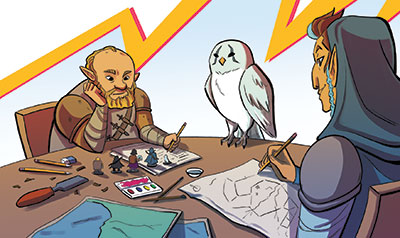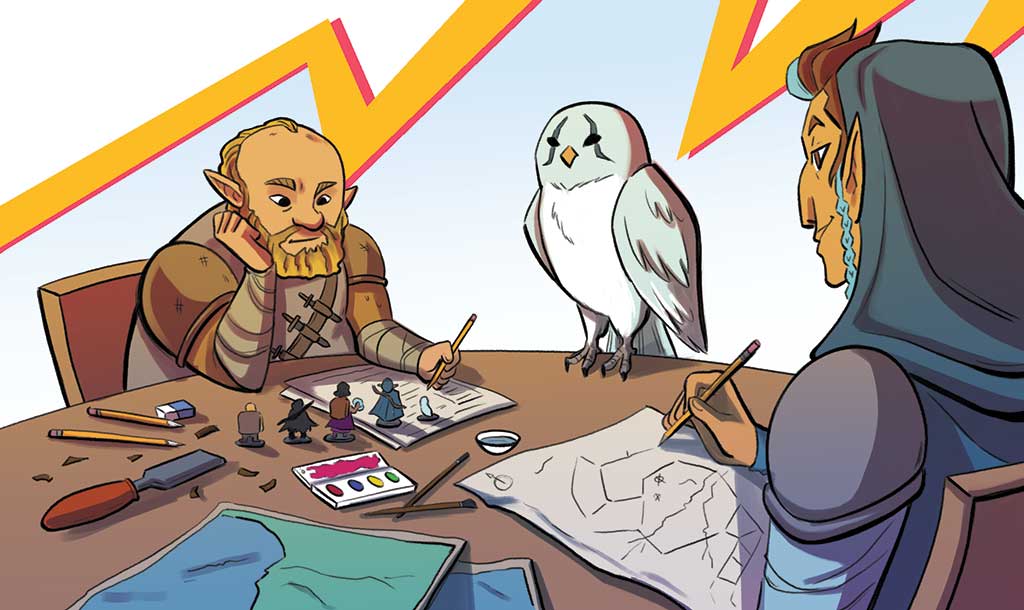Homebrew Homeschool: A Crash Course in Content Creation
- April 24, 2019
- Articles
- Posted by Brooke Jaffe
- Comments Off on Homebrew Homeschool: A Crash Course in Content Creation
A waterbender smothers the fire of a dragon as it breathes over their party. A druid befriends soot sprites in the ashes of a hearth. A bard discovers that electricity, when channeled through their guitar, makes for a pretty rockin’ instrument.
Waterbenders and soot sprites and electric guitars may not be content endemic to your tabletop system, but you can still bring them into your game! How, you ask? Through Homebrew!
What Is Homebrew?
Homebrew is what we call unofficial content made for a tabletop system by fans or players. “Homebrew” is the broad term—it can refer to anything from a new item to a new monster, race, or feat.
So, other than creating cool stuff for your campaign based on your favorite media, why use Homebrew content?
First: It lets you customize your game to your table. Every party is different: different people, different play styles, aesthetics, experience levels. Being able to craft things for those people, things that speak to what they want to get out of a play experience, helps personalize things for your players and gives them more of a stake in the world. If your player makes a character who’s a former pirate with an ancient curse, then wouldn’t it be cool to make a curse mechanic that affects their gameplay? It helps cement that character’s personal features in the world: both narratively and mechanically.
Second: The designers who create content for the official sourcebooks can’t, and won’t, think up everything you can. They don’t know your table, and they can’t predict everything your party will do. You can fill in the gaps of official content with your own ideas and create a level of adaptability that can take your campaign in new and exciting directions!
Last, but not least: It can spice up your campaign’s world. Everyone has played standard classes, fought standard monsters, used standard spells—but what about throwing in something new? Homebrewing novel and exciting monsters and classes and weapons is far from an exact science; but for GMs, having the ability to generate new content can mean that difference between a game that feels like standard medieval fantasy and something truly unique.
How Do I Start Building My Own Homebrew?
Let’s break it down into phases: Ideation, Prototyping, Playtesting, and Revision. If any part of that sounds complicated and jargon-y, don’t worry—we’re going to take it step by step.
Adventures in Ideation
Everything begins with an idea, and ideas begin with inspiration! What are you using for inspiration? Is it a setting, a myth, a character from your favorite book? Find something that gets you (or your players) excited.
Now consider: what are the essential parts of that concept you want to focus on? What makes that thing so exciting to you, or to your player? Write these down. They’re going to serve as the architecture of your Homebrew. Are they aesthetic? Are they mechanical? Think about why you feel strongly about those points in particular. Write down a couple of words about those reasons. If it’s an aesthetic, consider the kind of language you use to describe those features and consider implementing that in your design. For example: if you want to make a pirate class, think about seafaring terms: how pirates talk, dress, act. Keep all of those in mind for when you’re building out the features of your class. It’ll lend spice and style to your work!
Prototyping for Play
Now that you have an idea of what you want to create, let’s start building prototypes.
 What kind of content are you making? If you’re building a new class, make a list of all of the features of a standard build: Classes have at-will abilities, things that recharge on a short or long rest. Classes give proficiencies in different skills, armor types, and saving throws. Does your class have magic? If so, is it a half-caster or a full-caster? What spell list can they choose from? How many abilities do they get as they level up, and how do their initial abilities scale with experience? Look at a canon class to make a list of what aspects you’ll need to specify to make sure your class can stand alongside any canon one from the book.
What kind of content are you making? If you’re building a new class, make a list of all of the features of a standard build: Classes have at-will abilities, things that recharge on a short or long rest. Classes give proficiencies in different skills, armor types, and saving throws. Does your class have magic? If so, is it a half-caster or a full-caster? What spell list can they choose from? How many abilities do they get as they level up, and how do their initial abilities scale with experience? Look at a canon class to make a list of what aspects you’ll need to specify to make sure your class can stand alongside any canon one from the book.
Do this with any other kind of Homebrew. What features come with a particular race? What about magical items: their power, their school of magic, their cost? Once you know what you have to decide, we can start putting ideas into place.
To continue with the pirate example: I decided that any good pirate worth their salt should know how to sail, and probably knows how to navigate, too. In order to put that into my new pirate class, I give all pirates proficiency with boats, and advantage on Survival or Intelligence checks related to navigating through the open ocean. Since they use both simple blades and also ranged fare like early firearms or light crossbows, my pirates have proficiency in simple melee weapons and simple ranged weapons.
Pay close attention to how what you’re making aligns with existing material. Does your new spellcaster class have a d12 as their Hit Dice? That’s the same as a barbarian; you might want to take a look at how that compares to sorcerers, or wizards, and adjust accordingly. Is your new evil ent monster supposed to be fought by a small party at level 3, even though its stats look comparable to a CR 13 storm giant? When in doubt, make use of free online tools: there are calculators for CR and databases of content to reference and compare. A lot of these sorts of imbalances will show themselves in playtesting, but if you can save yourself the trouble by keeping a sharp eye out and learning how to self-edit, your creative process will be much smoother.
If the thought of coming up with something totally new and off-the-wall still feels a little intimidating, I recommend taking something you like that already exists in the game and modifying it. Change the abilities with new names, vocabulary, or a different kind of damage to give them a new flavor. It’s a simple and easy way to breathe new life into existing content, and is a great first step towards becoming more confident in your Homebrewing skills!
The Value of Playtesting
Once you have your first draft of a build done, get a few friends together and try it out in a one-shot game, or in an encounter that’s comparable to one in the game you’re ultimately trying to create for. It may seem like a bit of a pain to go do lots of testing before getting to use your shiny new Homebrew content, but trust me: playtesting is invaluable, and will save you a lot of trouble down the line.
Why, you ask? Well, playtesting has a lot of benefits. First, it helps you discover problems you can’t anticipate. Any GM can recall a time when they spent lots of time planning an encounter or a plot, only to have their party do something that they didn’t expect and throw everything off their perfectly-plotted course! Homebrew is no different. Players are always going to find ways to use (and abuse) your content that you never thought of. Playtesting lets them run amok in a controlled environment and not your actual campaign.
Second, you get another pair of eyes on your work! Sometimes things that seem perfectly clear to you make no sense to someone else. When in doubt, look things over with a trusted player or a fellow GM.
Finally, playtesting often helps generate new ideas. Do you end up using one ability or feature particularly often? Maybe make it the central mechanic! How can you play with that to make it more versatile, or more fun?
The Art of Revision
With a solid playtest under your belt, go back to your initial concept. Did your Homebrew evoke the feelings or experiences you set out to capture? Talk to your playtesters. Did they get those feelings, or have those experiences? Did it feel overpowered, or underpowered? Did they have fun?
Listen to their feedback and decide what, if anything, needs work. Take your Homebrew back to the drawing board, tweak it, and test it again! More often than not you’ll have to do a lot of playtesting and revising and playtesting again to get something that feels right. It may seem exhausting, and sometimes you might even get a little frustrated—but know that each iteration takes you closer and closer to your goal.
A Note on Overpowered (“OP”) Content and Balancing:
Balancing is far and away one of the most difficult parts of any kind of game design. It’s subjective, and fickle, and in the end there’s no right answer except the one that means your player’s experience is the experience you set out to evoke. With homebrew, it’s easy to let things get out of hand. You want your creations to be the coolest! But you also don’t want to dishearten your players by making some seriously OP stuff.
For example: I was in a campaign where our paladin was a 500-year-old haunted suit of armor dedicated to a god of competition and battle. He was awesome, and the character was great—but he had a LOT of OP homebrew content that made him so powerful any given fight had to be calibrated to him specifically. Many of the other players felt alienated. Why bother taking part in a fight if this one guy could practically win it on his own, anyway?
Now, there are a few ways to solve this problem. One is to nerf the OP player’s mechanics—which can work, but doesn’t feel good for the person getting nerfed and has the potential to continue feelings of inequity between the person singled out and the rest of the party. Narrative arcs can soften that blow if it’s worked in elegantly, but your mileage may vary depending on how story-focused your party is.
In the end we went with another solution: level the playing field. No one is “over”-powered if everyone is, so create homebrew content for everyone that lets each of your players feel as cool and special as the next! This can sometimes backfire and mean a more difficult job for the GM, trying to juggle lots of powerful characters; but as a GM I tend to prefer players all feeling as badass as possible—even if it means I have to build my encounters around it.
Ultimately, when you implement homebrew content the key is to keep communication with your players open to get feedback. If they aren’t happy, listen to them and stay flexible! The game is about having fun, after all, so the most important thing is always if you and your players are all enjoying your campaign. If that means having to scrap an idea because it threw things out of balance, or having to go through a few more cycles of testing and revision, then it’s worth it.
In Conclusion…
Part of the beauty of tabletop gaming is that, because it’s analog, you don’t have to be a programmer to get your hands dirty and play around with the gears that make up the system. Unlike video games, where all of the calculations and randomness and stat-crunching is happening inside the bowels of a computer, in tabletop the GM and players serve as the medium through which the game happens; and you (yes, you!) are more flexible and more powerful than any game engine out there! You can change things on the fly, create new and exciting original ideas, modify this game at-will—so why not try it out?
Homebrew your heart’s desire. It may look intimidating, but I promise you: you can do it, and it’s worth it.
 Brooke Jaffe is a game designer and writer currently completing an MFA in Interactive Media and Game Design at USC. You can find her streaming all sorts of gaming content (tabletop and otherwise) weekly on her Twitch channel The Stellar B (twitch.tv/TheStellarB)/@theStellarB).
Brooke Jaffe is a game designer and writer currently completing an MFA in Interactive Media and Game Design at USC. You can find her streaming all sorts of gaming content (tabletop and otherwise) weekly on her Twitch channel The Stellar B (twitch.tv/TheStellarB)/@theStellarB).


